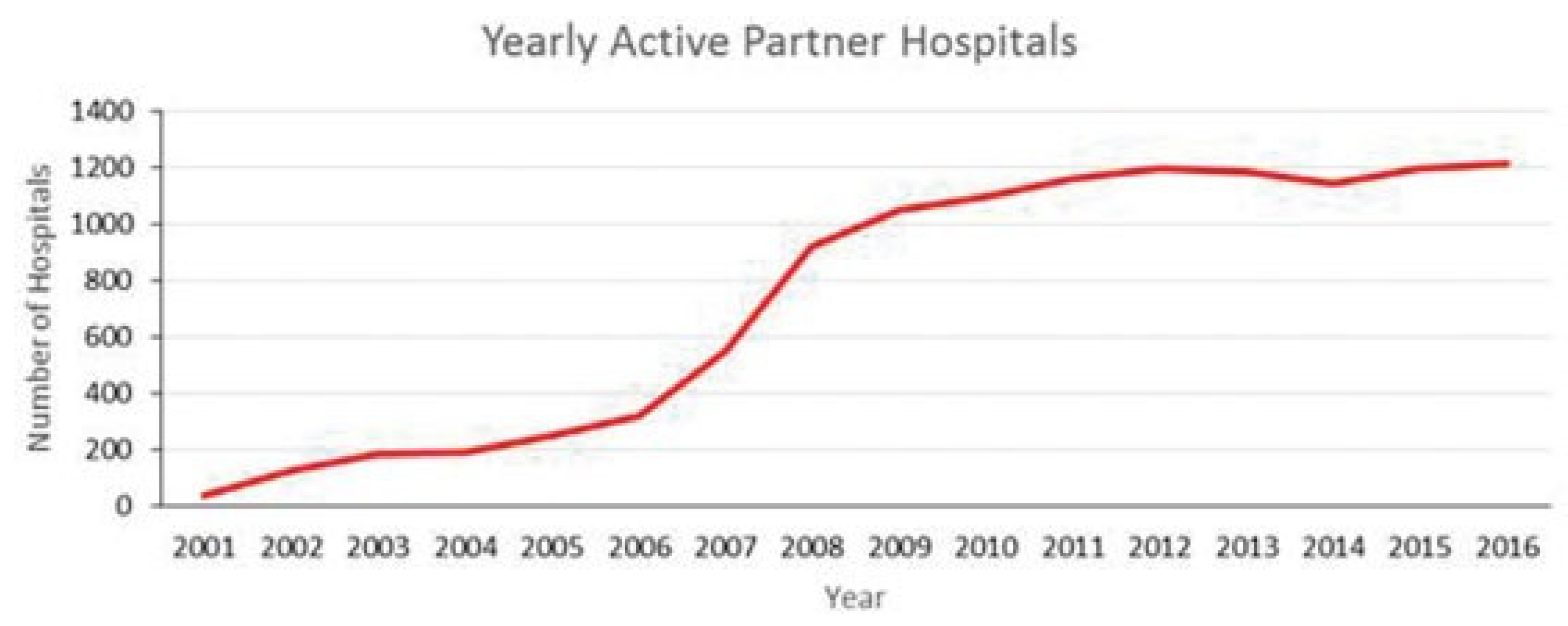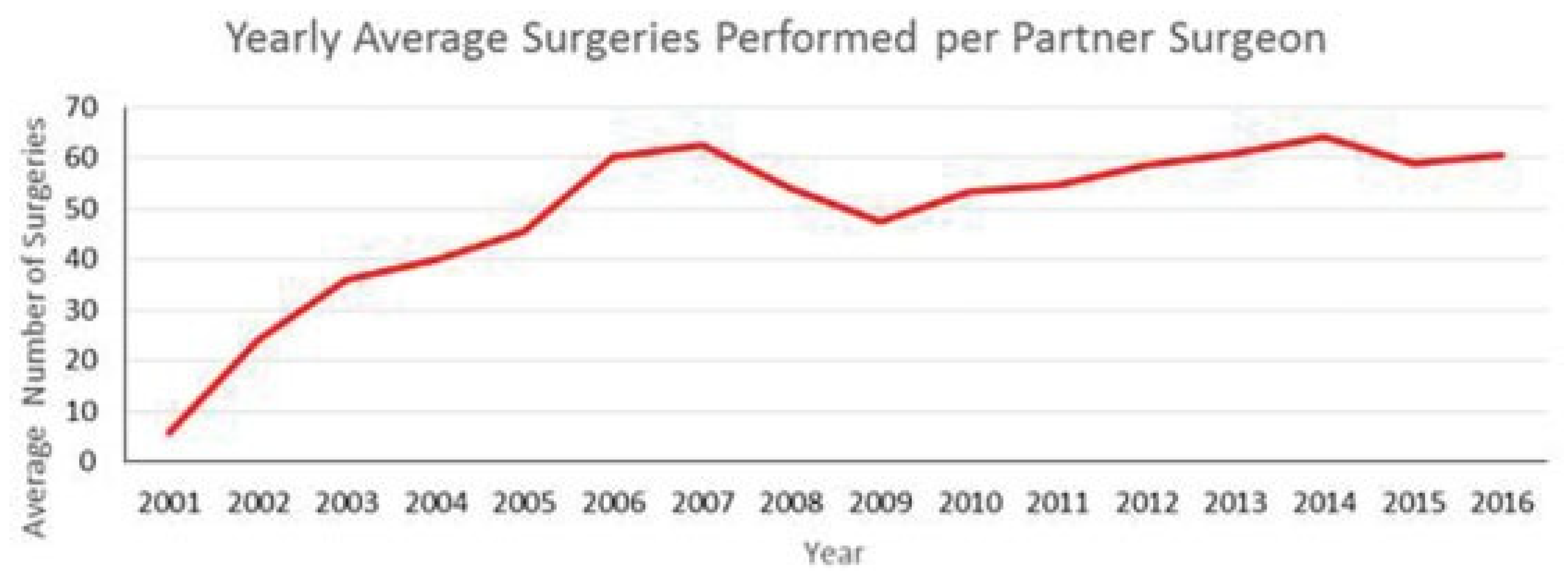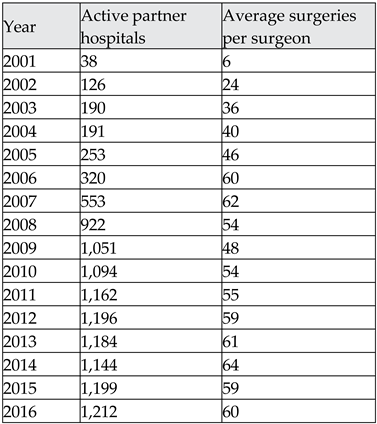The incidence of cleft lip with or without cleft palate is approximately 1/500 to 1/2500 live births [
1,
2]. Orofacial clefts present a significant medical and psychological burden across the world, especially in developing countries where clefts are not seen as a priority, leaving children to suffer with these deformities for the rest of their lives [
3,
4]. In response to the great need for care of these patients in low- and middle-income countries, many medical mission groups have formed to organize surgeons and other health care providers for trips to developing countries to provide essential cleft surgical care. However, these groups often face significant challenges with quality of care [
5,
6], continuity of comprehensive care including speech therapy and orthodontics [
7,
8,
9], disruption or disempowerment of local medical professionals and health systems, and a paucity of outcomes research [
8,
10,
11,
12,
13].
Recently, an international task force on cleft lip and palate care raised additional concerns about the mission model. Among the concerns discussed are record keeping, outcome evaluation, and the provision of follow-up care and staged treatment required in cleft patients [
9]. The Task Force Beyond Eurocleft stated, “the mission method of providing care is an old model and must be reserved for areas that do not have ANY capability of providing cleft care. There should be national and international coordination and cooperation in their delivery where these are undertaken” [
9]. While there are still proponents of this model of care, even they would generally agree that it is often not in the best interest of the patient or a sustainable model to address the global burden of orofacial clefting. Ultimately, the answer must lie locally.
Smile Train, an international children’s charity, was created in 1999 with a clear vision: create a sustainable network of local hospitals and surgeons who are empowered to provide comprehensive cleft care in their own communities. The organization’s “teach a man to fish” model has provided training, funding, and resources to local doctors in more than 85 countries, empowering them to provide free cleft surgery and comprehensive cleft care in their communities. Since its inception, Smile Train has treated more than 1 million patients worldwide.
Cleft care sponsored by Smile Train is required to be conducted in compliance with global quality standards developed by the organization. Smile Train has refined these standards, which include detailed safety and quality protocols for treatment, over the past 16 years. A thorough quality review process is mandated with partner hospitals and surgeons which requires organized record keeping and systematic review of surgery results. Surgeons must be certified in their country; demonstrate quality in cleft surgery (as evidence by Smile Train’s Quality Assurance processes); and be registered in Smile Train Express, Smile Train’s secure, global, proprietary patient record database (
www.smiletrainexpress.org).
Patients are carefully selected for surgery through clear guidelines outlined in Smile Train’s safety and quality protocols. Expectations for anesthesia staff and equipment are well defined and adherence is mandatory. Complications are reported; carefully analyzed through local leadership, Smile Train Headquarters, and a Medical Advisory Board; and recommendations or interventions such as training initiatives are implemented to avoid recurrence. A quality assurance monitoring review process is in place to provide feedback on the quality of surgical treatment for local medical providers and to ensure high-quality care.
Partner Hospitals
Local hospitals and surgeons who are potential partners are identified with the help of existing partners and locally based Smile Train staff. During Smile Train’s early years, the majority of partner hospitals were identified by regional Smile Train staff. As the organization grew and its reputation for offering excellent care for cleft patients as well as supporting the local medical community through training and continuing education became well known, hospitals began to seek out Smile Train’s partnership.
Prior to partnership, each hospital is required to complete a Smile Train Treatment Partnership Application and the entire surgical team and facility undergo a thorough audit. If selected, partners sign a contract obligating them to Smile Train’s Safety & Quality Protocol, Anesthesia Guidelines, and the World Health Organization Surgical Safety Checklist. The safety protocols mandated by Smile Train complement the partner hospital’s standards and protocols. Together, these guidelines include patient pre-screening requirements, parameters for patient selection, and facility and equipment requirements and also provide standards for the operating room as well as pre- and postoperative care. Additionally, each partner is required to meet rigorous reporting requirements for the cleft care being provided as well as any complications encountered.
Figure 1 and
Figure 2 and
Table 1 demonstrate the growth of Smile Train through the increase of number of surgeries per year and number of yearly active partner hospitals. From 2001 to the end of 2016, more than 1,290,000 cleft surgeries have been performed by Smile Train partners.
Ensuring Quality in Partner Surgeons
To ensure consistent, high-quality cleft care, surgeons must demonstrate proficiency and an adequate volume of cleft surgeries evidenced by provision of patient lists and surgical schedules. Surgeons must be certified in maxillofacial or plastic surgery in their country or trained in cleft surgery and registered to upload cases into the Smile Train Express database. A quality assurance monitoring process developed by the Smile Train Medical Advisory Board is used to assess a new partner surgeon’s recent cleft case outcomes. An evaluation of the first 10 lip cases and the first 5 palate cases is completed. Until these cases are completed and reviewed, the surgeon is in a probationary period. Upon satisfactory completion of the evaluation process, subsequent cases sponsored by Smile Train enter a pool of which ~5% of cases are reviewed per year. Surgeons who do not meet Smile Train’s standards in the initial evaluation are subject to further reviews, training, and in some cases, termination. The treating surgical team should review patient records and treatment outcomes on an ongoing basis.
Figure 2 demonstrates the increase in average cleft surgeries performed by partner surgeons since 2001 with the largest increase between 2001 and 2006.
Training
Training is organized around specific skills using didactic and hands-on teaching, with a focus on leveraging local or regional trainers. Hands-on quality improvement trainings include one-on-one training programs and small group workshops that are organized by Smile Train to improve surgical outcomes across our partner network. Thesetraining and exchange programsare often the result of needs identified through Smile Train’s Quality Assurance Monitoring Process, the Smile Train Express patient database, or observations from Smile Train’s Medical Advisory Boards and global staff. Most of thesetrainings are conducted by trainers who are in the same country or region as the trainee(s), while some are South-South collaborations where surgeons in need of training may train at a high-volume Smile Train partner facility elsewhere in the developing world. Since 1999, Smile Train has sponsored more than 3000 hands-on training opportunities.
Smile Train also supports partner surgeons with scholarships to attend national and international cleft meetings including select training opportunities with the American Society of Plastic Surgeons, the Plastic Surgery Foundation, the International Cleft Lip and Palate Association, and the American Cleft Palate-Craniofacial Association. In total, Smile Train has offered morethan 30,000 opportunities to participate in academic and professional conferences. Additionally, the Smile Train Medical Resource Library offers Smile Train partners access to the world’s largestonline cleft libraryat no cost sothat they can stay current in best practices and research in cleft care. Yet another resource provided is the Smile Train Virtual Surgery Simulator. Launched in 2013, this resource is a freely available, web-accessible surgical simulator that provides instruction for cleft lip and palate repair and has more than 2600 users spanning 137 countries. The simulator is based on a DVD training tool developed by Smile Train and used for over a decade, and employs interactive animated graphics, written and oral instruction, and actual intraoperative surgical video footage to provide clear instruction on surgical procedures in detail. Since 2013, there have been more than 40,000 virtual cleft training opportunities.
Providing a Safe Surgical Environment
A safe surgical environment is fostered by various measures facilitated by a hospital’s partnership with Smile Train. Use of the World Health Organization Surgical Safety Checklist is mandated to ensure safety in the operating room. In a study of 12 hospitals partnered with Smile Train, all hospitals began using the preoperative checklist for cleft surgery and 5 of those hospitals also began using the checklist for other surgical disciplines [
6]. To ensure that surgical safety is maximized in each case, more complex procedures such as cleft palate repair and surgeries on smaller and younger patients should be strategically scheduled earlier in the day. The facility must demonstrate experience in cleft surgery by having performed cleft procedures regularly in the preceding 6 months. Operating room personnel must be experienced in sterile techniques and access to sterilizing equipment is required. Reminders must be placed in the operating suite of the need for removal of throat packing.
Selecting Surgical Candidates
Before being scheduled for surgery, cleft patients undergo a thorough history and physical examination. Basic screening laboratory studies, including a complete blood count (and coagulation studies for cleft palate patients), are obtained. Imaging such as chest X-rays is not routinely used unless indicated by physical exam. Electrocardiography is reserved for patients with abnormalities encountered on the cardiovascular exam. Informed consent is obtained prior to cleft care being provided and each patient undergoing a sponsored cleft surgery has a medical record that is uploaded to Smile Train Express.
To optimize postoperative results, surgery is delayed or rescheduled for malnourished patients and patients experiencing symptoms suggestive of a respiratory tract infection. Smile Train will not sponsor surgery for any patient who, during history and physical exam, is found to be at high risk of developing perioperative complications, surgical or anesthetic. Smile Train will not sponsor surgery for any patient younger than 3 months for lip repair or younger than 6 months for palate repair. Further, patients should be of the appropriate weight for their age and Smile Train will not sponsor surgery for any patient who weighs less than 5 kg. It is recommended that patients should have a hemoglobin level of at least 10 g/Hb to ensure safe surgery. It is mandated that no Smile Train patient should undergo a preoperative blood transfusion to increase hemoglobin level.
Anesthesia Guidelines
Before partnering with Smile Train, the hospital’s ability to provide safe anesthesia to young children is carefully scrutinized. Anesthetists are mandated to have current certification and experience administering anesthesia to pediatric patients on a weekly and, preferably, daily basis over the preceding 24 months. At a minimum, the facility must have vaporizers for halothane or sevoflurane; a functioning oxygen supply; and a sufficient drug formulary for antibiotics, intravenous hypnotics, oral analgesics, muscle relaxants, and emergency drugs. All monitoring instruments (ECG leads, pulse oximeters, blood pressure cuffs, and stethoscopes) must be appropriately sized for children.
There are preoperative guidelines for patient NPO status prior to surgery. Formulas for the administration of maintenance fluids as well as appropriate correction for blood and third space losses are provided. Per the guidelines, vitals are recorded and charted every 5 minutes during the operation.
Extubation is initiated only once the patient’s airway is stabilized. Gentle suction is used in the oropharynx and the nares with careful attention to suture lines and wounds. Postoperative nausea and vomiting prophylaxis is provided with either ondansetron or metoclopramide in patients older than 1 year. During this time, the surgeon should be present with the instrument table set up and a tracheostomy tray readily available.
Once patients are awake and breathing spontaneously, they are transported to the PACU which must be adjacent to the operating suite and staffed with a 1:1 patient:nurse ratio. PACU nurses should be trained in airway management and recognition of airway obstruction, bleeding, hypo-/hyper-tension, respiratory distress, and hypoxemia. Smile Train offers training on postoperative care for nurses to ensure these capabilities in nursing staff.
The patient is typically kept in the hospital for observation for the first night after surgery, though the exact length of time can vary based on the protocols in place at the partner hospital. During the first 6 to 8 hours after the surgery, the patient should be monitored hourly for respiratory complications or signs of bleeding. The patient’s diet is advanced as tolerated, and pain management protocols are observed. Before discharge, the patient’s family is educated on proper wound care management and provided strict return precautions per the Smile Train Postoperative Discharge Checklist.
Conclusions
For the past 16 years, Smile Trainand its partners have provided more than 1.2 million safe, high-quality cleft surgeries and extensive related treatments. Through rigorous self-governance and its sustainable, scalable model, this organization has elevated the standard of cleft care in the developing world. Smile Train, more than any other philanthropic surgical organization to date, has created a lasting effect and exemplified the old adage, “Give a man a fish, and you feed him for a day. Teach him to fish, and you feed him for a lifetime”.
Disclosures
Dr. Hollier is a consultant for Stryker and also serves as chairman of the medical advisory board for Smile Train.






